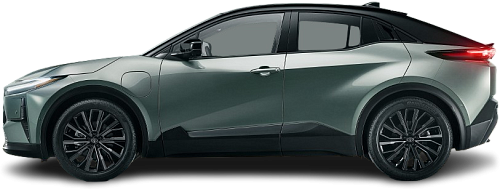Global EV Comparison: Nissan Leaf 52 kWh vs Toyota C-HR+ 57.7 kWh FWD
Struggling to Decide? Let AI Help!
Your AI Summary Is Ready!
General Info
Although both vehicles have been announced, they are not yet in production and will not be available for sale in Europe.
The two vehicles share the same body style: SUV.
| Property | Nissan Leaf 52 kWh | Toyota C-HR+ 57.7 kWh FWD |
|---|---|---|
| Years of Production | 2025-… | 2025-… |
| Current Status | Announced | Announced |
| Country of Manufacture | Japan, UK, USA | Japan, China |
| Body Style | SUV | SUV |
| Market Availability | EU, USA | EU, USA |
| GCC Score | 5.6 | 6 |
Range and Efficiency
While the Toyota C-HR+ 57.7 kWh FWD (2025-…) offers a longer real-world range and a bigger battery, it is less energy-efficient than the Nissan Leaf 52 kWh (2025-…).
| Property | Nissan Leaf 52 kWh | Toyota C-HR+ 57.7 kWh FWD |
|---|---|---|
| Range (EPA) | 402 km | - Range (EPA) |
| Range (WLTP) | - Range (WLTP) | 455 km |
| Range (GCC) | 382 km | 387 km |
| Battery Capacity (Nominal) | 52 kWh | 57.7 kWh |
| Battery Capacity (Usable) | 49.4 kWh | 51.9 kWh |
| Efficiency per 100 km | 12.9 kWh/100 km | 13.4 kWh/100 km |
| Efficiency per kWh | 7.73 km/kWh | 7.46 km/kWh |
| Range and Efficiency Score | 8.1 | 8.1 |
Charging
Both vehicles utilize a standard 400-volt architecture.
Both vehicles support DC fast charging with a maximum power of 150 kW.
The Toyota C-HR+ 57.7 kWh FWD (2025-…) features a more powerful on-board charger, supporting a maximum AC charging power of 11 kW, whereas the Nissan Leaf 52 kWh (2025-…) is limited to 7.2 kW.
| Property | Nissan Leaf 52 kWh | Toyota C-HR+ 57.7 kWh FWD |
|---|---|---|
| Max Charging Power (AC) | 7.2 kW | 11 kW |
| Max Charging Power (DC) | 150 kW | 150 kW |
| Architecture | 400 V | 400 V |
| Charge Port | CCS Type 2 | CCS Type 2 |
| Charging Score | 4.6 | 5.9 |
Performance
Both vehicles are front-wheel drive.
The Nissan Leaf 52 kWh (2025-…) boasts greater motor power and accelerates faster from 0 to 100 km/h.
| Property | Nissan Leaf 52 kWh | Toyota C-HR+ 57.7 kWh FWD |
|---|---|---|
| Drive Type | FWD | FWD |
| Motor Type | PMSM | PMSM |
| Motor Power (kW) | 130 kW | 123 kW |
| Motor Power (hp) | 174 hp | 165 hp |
| Motor Torque | 345 Nm | 228 Nm |
| 0-100 km/h | 7.5 s | 8.6 s |
| Top Speed | 144 km/h | 160 km/h |
| Performance Score | 3.3 | 3 |
Dimensions
The Toyota C-HR+ 57.7 kWh FWD (2025-…) is longer, wider, and taller.
The Toyota C-HR+ 57.7 kWh FWD (2025-…) boasts a more extended wheelbase.
| Property | Nissan Leaf 52 kWh | Toyota C-HR+ 57.7 kWh FWD |
|---|---|---|
| Length | 4405 mm | 4520 mm |
| Width (with Mirrors) | 2099 mm | - Width (with Mirrors) |
| Width (w/o Mirrors) | 1810 mm | 1870 mm |
| Height | 1557 mm | 1595 mm |
| Wheelbase | 2690 mm | 2750 mm |
Cargo and Towing
Neither car is equipped with a frunk (front trunk).
The Toyota C-HR+ 57.7 kWh FWD (2025-…) has a towing capacity of up to 750 kg, whereas the Nissan Leaf 52 kWh (2025-…) is not officially rated for towing in the EU.
| Property | Nissan Leaf 52 kWh | Toyota C-HR+ 57.7 kWh FWD |
|---|---|---|
| Number of Seats | 5 | 5 |
| Curb Weight | 1794 kg | - Curb Weight |
| Cargo Volume (Trunk) | 565 l | 416 l |
| Cargo Volume (Max) | 1573 l | - Cargo Volume (Max) |
| Cargo Volume (Frunk) | - Cargo Volume (Frunk) | - Cargo Volume (Frunk) |
| Towing Capacity | - Towing Capacity | 750 kg |
| Cargo and Towing Score | 5.8 | 6.3 |




